Web-Based BFlow System for the Assessment of Streamflow Characteristics at National Level
Abstract
:1. Introduction
2. Materials and Methods
2.1. Study Area and Data
2.2. Digital Filter Method
2.3. Development of the Web-Based BFlow System
3. Results
3.1. The Developed Web-Based BFlow System
3.2. Analysis of River Characteristics
4. Discussions and Conclusions
Supplementary Materials
Acknowledgments
Author Contributions
Conflicts of Interest
References
- Wilby, R.L.; Whitehead, P.G.; Wade, A.J.; Butterfield, D.; Davis, R.J.; Watts, G. Integrated modelling of climate change impacts on water resources and quality in a lowland catchment: River Kennet, UK. J. Hydrol. 2006, 330, 204–220. [Google Scholar] [CrossRef]
- Corsi, S.R.; Borchardt, M.A.; Spencer, S.K.; Hughes, P.E.; Baldwin, A.K. Human and bovine viruses in the Milwaukee River watershed: Hydrologically relevant representation and relations with environmental variables. Sci. Total Environ. 2014, 490, 849–860. [Google Scholar] [CrossRef] [PubMed]
- Kim, J.S.; Jain, S.; Yoon, S.K. Warm season streamflow variability in the Korean Han River Basin: Links with atmospheric teleconnections. Int. J. Climatol. 2012, 32, 635–640. [Google Scholar] [CrossRef]
- Jung, I.W.; Bae, D.H.; Lee, B.J. Possible change in Korean streamflow seasonality based on multi-model climate projections. Hydrol. Process. 2013, 27, 1033–1045. [Google Scholar] [CrossRef]
- Jeong, C.; Lee, T. Copula-based modeling and stochastic simulation of seasonal intermittent streamflows for arid regions. J. Hydro-Environ. Res. 2015, 9, 604–613. [Google Scholar] [CrossRef]
- Kim, S.J.; Kwon, H.J.; Park, G.; Lee, M.S. Assessment of land-use impact on streamflow via a grid-based modelling approach including paddy fields. Hydrol. Process. 2005, 19, 3801–3817. [Google Scholar] [CrossRef]
- Chang, H.; Franczyk, F. Climate change, land-use change, and floods: Toward an integrated assessment. Geogr. Compass 2008, 2, 1549–1579. [Google Scholar] [CrossRef]
- Kim, Y.; Chung, E.S. Integrated assessment of climate change and urbanization impact on adaptation strategies: A case study in two small Korean watersheds. Clim. Chang. 2012, 115, 853–872. [Google Scholar] [CrossRef]
- Kim, J.; Choi, J.; Choi, C.; Park, S. Impacts of changes in climate and land use/land cover under IPCC RCP scenarios on streamflow in the Hoeya River Basin, Korea. Sci. Total Environ. 2013, 452, 181–195. [Google Scholar] [CrossRef] [PubMed]
- Freeze, R.A. Role of subsurface flow in generating surface runoff. 2. Upstream source areas. Water Resour. Res. 1972, 8, 1272–1283. [Google Scholar] [CrossRef]
- Brutsaert, W.; Nieber, J.L. Regionalized drought flow hydrographs from a mature glaciated plateau. Water Resour. Res. 1977, 13, 637–643. [Google Scholar] [CrossRef]
- Eckhardt, K. How to construct recursive digital filters for baseflow separation. Hydrol. Process. 2005, 19, 507–515. [Google Scholar] [CrossRef]
- Stewart, M.; Cimino, J.; Ross, M. Calibration of base flow separation methods with streamflow conductivity. Ground Water 2007, 45, 17–27. [Google Scholar] [CrossRef] [PubMed]
- Barnes, B. The structure of discharge-recession curves. Trans. Am. Geophys. Union 1939, 20, 721–725. [Google Scholar] [CrossRef]
- Meyboom, P. Estimating ground-water recharge from stream hydrographs. J. Geophys. Res. 1961, 66, 1203–1214. [Google Scholar] [CrossRef]
- Rutledge, A.T. Computer Programs for Describing the Recession of Groundwater Discharge and for Estimating Mean Ground-Water Recharge and Discharge from Streamflow Records—Update; U.S. Geological Survey Water-Resources Investigations Report 98-4148; U.S. Geological Survey: Denver, CO, USA, 1993.
- Arnold, J.G.; Allen, P.M. Automated methods for estimating baseflow and ground water recharge from streamflow records. J. Am. Water Resour. Assoc. 1999, 35, 411–424. [Google Scholar] [CrossRef]
- Fetter, C.W. Applied Hydrogeology; Prentice Hall: Upper Saddle River, NJ, USA, 1994. [Google Scholar]
- Pettyjohn, W.A.; Henning, R. Preliminary Estimate of Ground-Water Recharge Rates, Related Streamflow and Water Quality in Ohio; Project Completion Report 553, Technical Report; Water Resources Centre, Ohio State University: Columbus, OH, USA, 1979. [Google Scholar]
- Linsley, R.K.; Kohler, M.A.; Paulhus, J.L.H. Hydrology for Engineers; McGraw Hill Book Company: London, UK, 1982. [Google Scholar]
- Sawaske, S.R.; Freyberg, D.L. An analysis of trends in baseflow recession and low-flows in rain-dominated coastal streams of the pacific coast. J. Hydrol. 2014, 519, 599–610. [Google Scholar] [CrossRef]
- Theis, C.V. Amount of ground-water recharge in the southern high plains. Trans. Am. Geophys. Union 1937, 18, 564–568. [Google Scholar] [CrossRef]
- Varni, M.; Comas, R.; Weinzettel, P.; Dietrich, S. Application of the water table fluctuation method to characterize groundwater recharge in the Pampa plain, Argentina. Hydrol. Sci. J. 2013, 58, 1445–1455. [Google Scholar] [CrossRef]
- Sloto, R.; Crouse, M. HYSEP: A Computer Program for Streamflow Hydrograph Separation and Analysis; U.S. Geological Survey, Water Resources Investigations, Report 96-4040; U.S. Geological Survey: Denver, CO, USA, 1996.
- Dai, Z.J.; Chu, A.; Du, J.Z.; Stive, M.; Hong, Y. Assessment of extreme drought and human interference on baseflow of the Yangtze River. Hydrol. Process. 2010, 24, 749–757. [Google Scholar] [CrossRef]
- Moreno, M.A.; Vieux, B.E. Estimation of spatio-temporally variable groundwater recharge using a rainfall-runoff model. J. Hydrol. Eng. 2011, 18, 237–249. [Google Scholar] [CrossRef]
- Kung, W.J.; Yeh, H.F.; Lin, H.I.; Chen, W.P.; Lee, C.H. An approach to evaluate groundwater recharge from streamflow and groundwater records. Geosci. J. 2013, 17, 353–362. [Google Scholar] [CrossRef]
- Partington, D.; Brunner, P.; Simmons, C.T.; Werner, A.D.; Therrien, R.; Maier, H.R.; Dandy, G.C. Evaluation of outputs from automated baseflow separation methods against simulated baseflow from a physically based, surface water-groundwater flow model. J. Hydrol. 2012, 458, 28–39. [Google Scholar] [CrossRef]
- Lim, K.J.; Engel, B.A.; Tang, Z.; Choi, J.; Kim, K.; Muthukrishnan, S.; Tripathy, D. Automated web GIS based hydrograph analysis tool, WHAT1. J. Am. Water Resour. Assoc. 2005, 41, 1407–1416. [Google Scholar] [CrossRef]
- Mondal, P.; Srivastava, P.; Kalin, L.; Panda, S.N. Ecologically sustainable surface water withdrawal for cropland irrigation through incorporation of climate variability. J. Soil Water Conserv. 2011, 66, 221–232. [Google Scholar] [CrossRef]
- Zhang, Y.; Ahiablame, L.; Engel, B.; Liu, J. Regression Modeling of Baseflow and Baseflow Index for Michigan USA. Water 2013, 5, 1797–1815. [Google Scholar] [CrossRef]
- Eckhardt, K. A comparison of baseflow indices, which were calculated with seven different baseflow separation methods. J. Hydrol. 2008, 352, 168–173. [Google Scholar] [CrossRef]
- Lyne, V.; Hollick, M. Stochastic time-variable rainfall–runoff modelling. In Hydrology and Water Resources Symposium; Institution of Engineers: Perth, Australia, 1979. [Google Scholar]
- Nathan, R.J.; McMahon, T.A. Evaluation of automated techniques for base-flow and recession analyses. Water Resour. Res. 1990, 26, 1465–1473. [Google Scholar] [CrossRef]
- Shi, X.; Wood, A.W.; Lettenmaier, D.P. How essential is hydrologic model calibration to seasonal streamflow forecasting? J. Hydrometeorol. 2008, 9, 1350–1363. [Google Scholar] [CrossRef]
- Ahiablame, L.; Chaubey, I.; Engel, B.; Cherkauer, K.; Merwade, V. Estimation of annual baseflow at ungauged sites in Indiana USA. J. Hydrol. 2013, 476, 13–27. [Google Scholar] [CrossRef]
- Ahiablame, L.; Engel, B.; Chaubey, I. An optimization method for estimating constituent mean concentrations in base flow-dominated flow. J. Am. Water Resour. Assoc. 2013, 49, 1167–1178. [Google Scholar] [CrossRef]
- Guo, J.; Li, H.Y.; Leung, L.R.; Guo, S.; Liu, P.; Sivapalan, M. Links between flood frequency and annual water balance behaviors: A basis for similarity and regionalization. Water Resour. Res. 2014, 50, 937–953. [Google Scholar] [CrossRef]
- Lee, G.; Shin, Y.; Jung, Y. Development of web-based RECESS model for estimating baseflow using SWAT. Sustainability 2014, 6, 2357–2378. [Google Scholar] [CrossRef]
- WAMIS Home Page. Available online: http://www.wamis.go.kr/ (accessed on 10 July 2016).
- Stewart, M.K. Promising new Baseflow separation and recession analysis methods applied to streamflow at Glendhu Catchment, New Zealand. Hydrol. Earth Syst. Sci. 2015, 19, 2587–2603. [Google Scholar] [CrossRef]
- Arnold, J.G.; Muttiah, R.S.; Srinivasan, R.; Allen, P.M. Regional estimation of base flow and groundwater recharge in the Upper Mississippi river basin. J. Hydrol. 2000, 227, 21–40. [Google Scholar] [CrossRef]
- Rouhani, H.; Malekian, A. Automated methods for estimating baseflow from streamflow records in a semi arid watershed. Desert 2013, 17, 203–209. [Google Scholar]
- Arnold, J.G.; Allen, P.M.; Muttiah, R.; Bernhardt, G. Automated base flow separation and recession analysis techniques. Ground Water 1995, 33, 1010–1018. [Google Scholar] [CrossRef]
- The Web-Based BFlow System. Available online: http://www.envsys.co.kr/~swatbflow (accessed on 30 April 2016).
- Google Map Home Page. Available online: https://www.google.co.kr/maps (accessed on 30 April 2016).
- Olden, J.D.; Kennard, M.J.; Pusey, B.J. A framework for hydrologic classification with a review of methodologies and applications in ecohydrology. Ecohydrology 2012, 5, 503–518. [Google Scholar] [CrossRef]
- Piao, S.; Friedlingstein, P.; Ciais, P.; de Noblet-Ducoudré, N.; Labat, D.; Zaehle, S. Changes in climate and land use have a larger direct impact than rising CO2 on global river runoff trends. Proc. Natl. Acad. Sci. USA 2007, 104, 15242–15247. [Google Scholar] [CrossRef] [PubMed]
- Beguería, S.; López-Moreno, J.I.; Lorente, A.; Seeger, M.; García-Ruiz, J.M. Assessing the effect of climate oscillations and land-use changes on streamflow in the central Spanish Pyrenees. AMBIO 2003, 32, 283–286. [Google Scholar] [CrossRef] [PubMed]
- Naver Map Home Page. Available online: http://map.naver.com (accessed on 30 April 2016).
- Australian Rainfall & Runoff. Available online: http://www.arr.org.au/revision-projects/project-list/project-7/ (accessed on 10 July 2016).
- Ahiablame, L.; Shakya, R. Modeling flood reduction effects of low impact development at a watershed scale. J. Environ. Manag. 2016, 171, 81–91. [Google Scholar] [CrossRef] [PubMed]
- Du, S.; Shi, P.; Van Rompaey, A.; Wen, J. Quantifying the impact of impervious surface location on flood peak discharge in urban areas. Nat. Hazards 2015, 76, 1457–1471. [Google Scholar] [CrossRef]
- Berghuijs, W.R.; Sivapalan, M.; Woods, R.A.; Savenije, H.H. Patterns of similarity of seasonal water balances: A window into streamflow variability over a range of time scales. Water Resour. Res. 2014, 50, 5638–5661. [Google Scholar] [CrossRef]
- Lee, J.H.; Bang, K.W. Characterization of urban stormwater runoff. Water Res. 2000, 34, 1773–1780. [Google Scholar] [CrossRef]
- Jang, C.; Kum, D.; Jung, Y.; Kim, K.; Shin, D.S.; Engel, B.A.; Shin, Y.; Lim, K.J. Development of a Web-Based L-THIA 2012 Direct Runoff and Pollutant Auto-Calibration Module Using a Genetic Algorithm. Water 2013, 5, 1952–1966. [Google Scholar] [CrossRef]
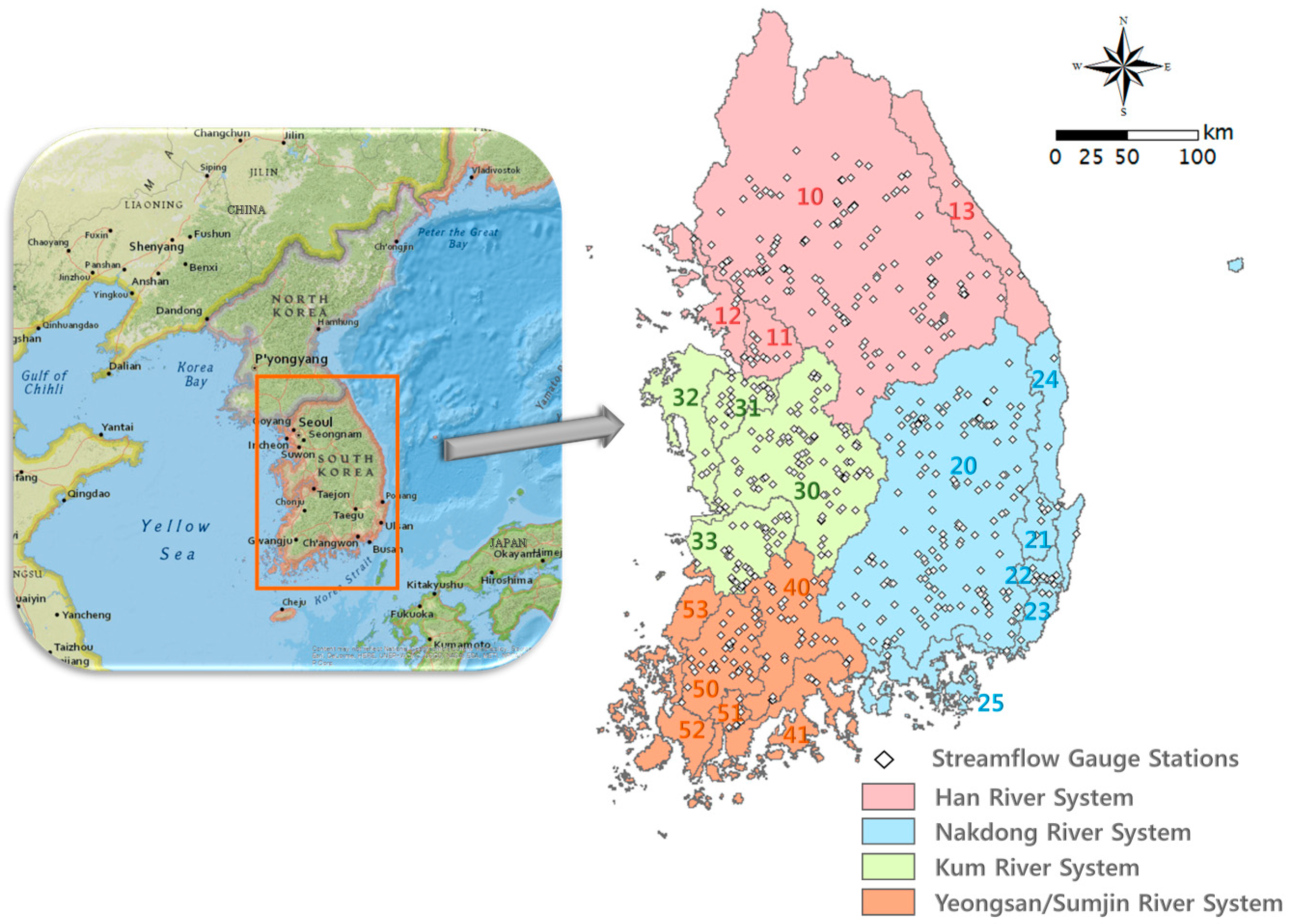
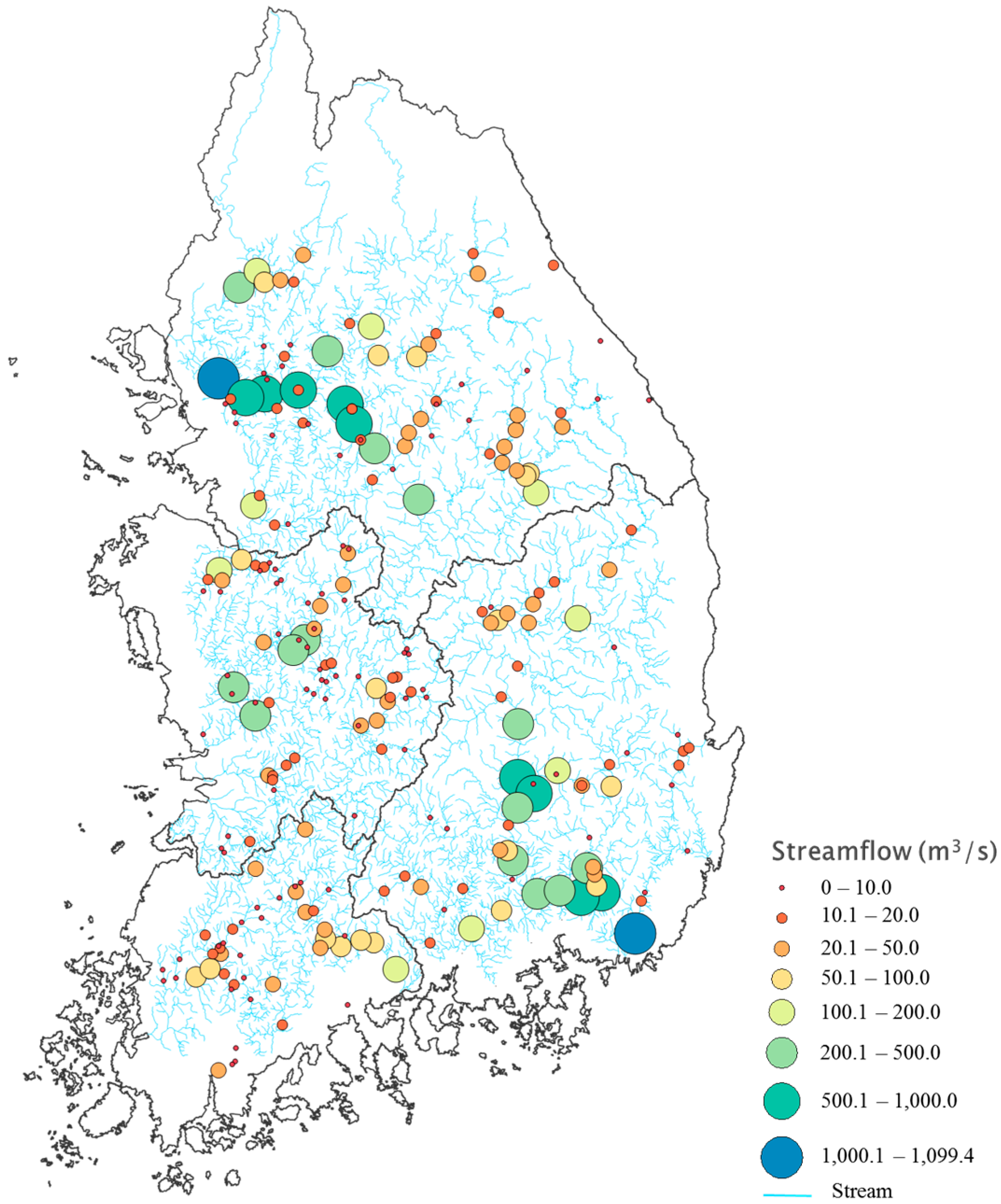
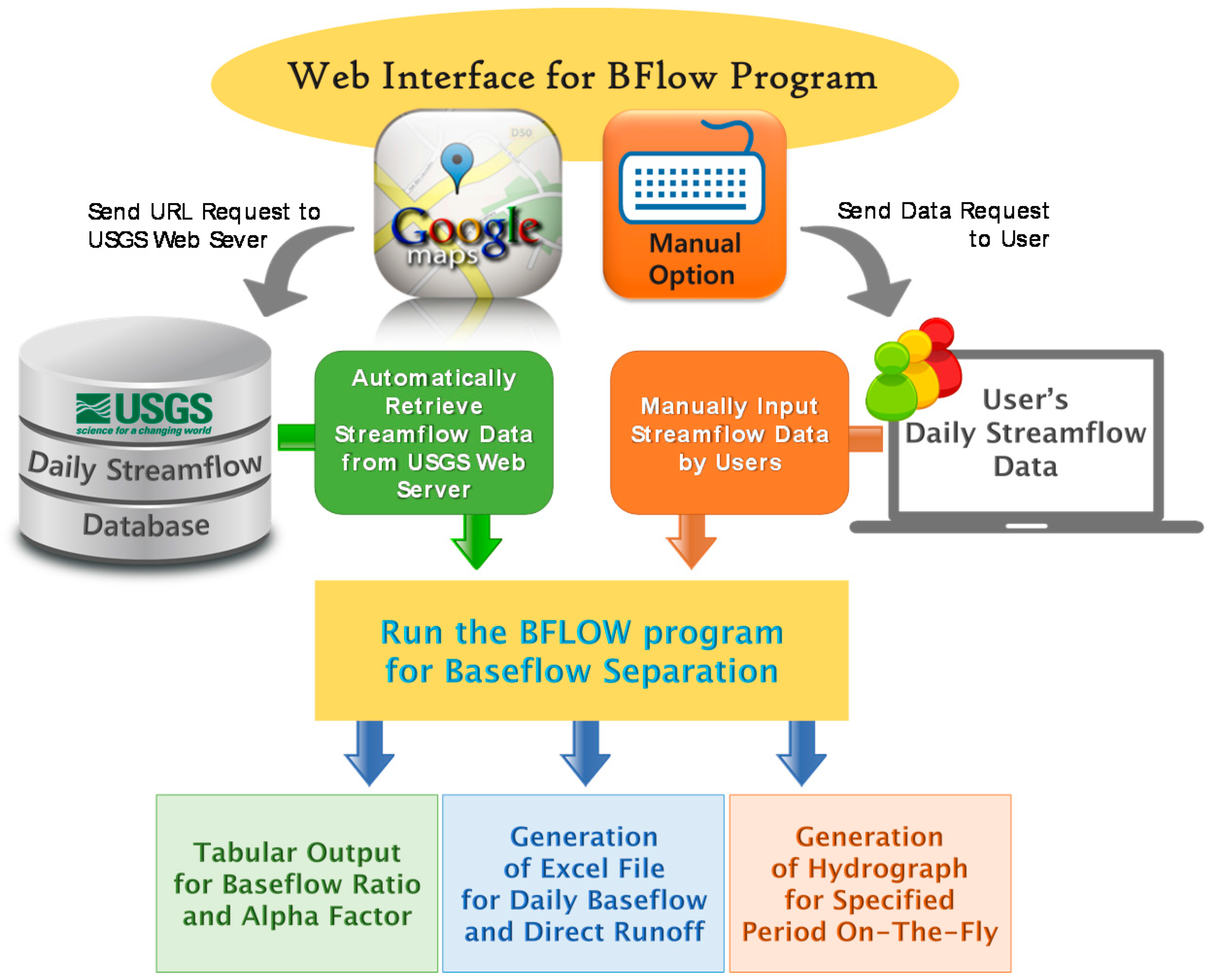

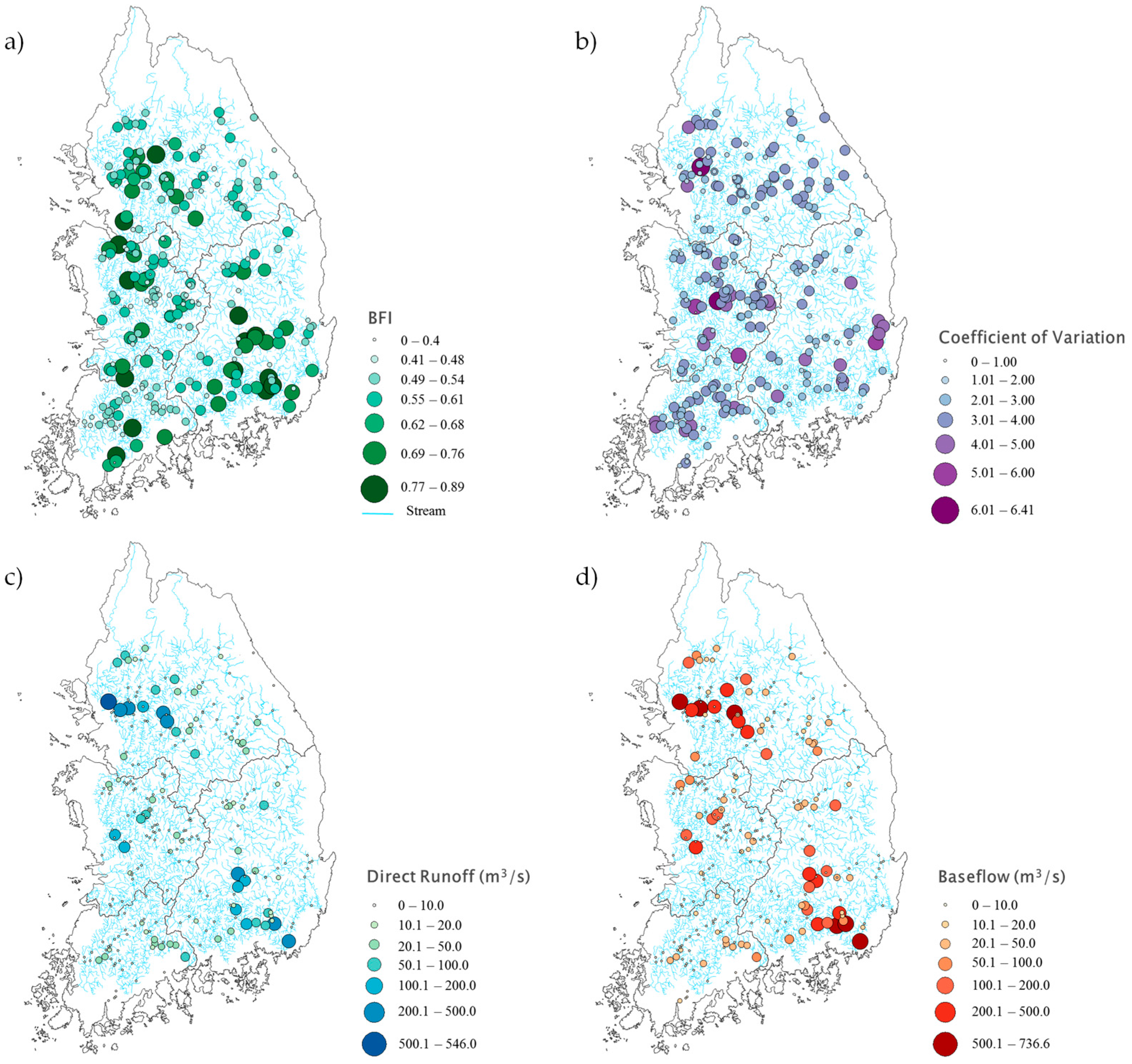
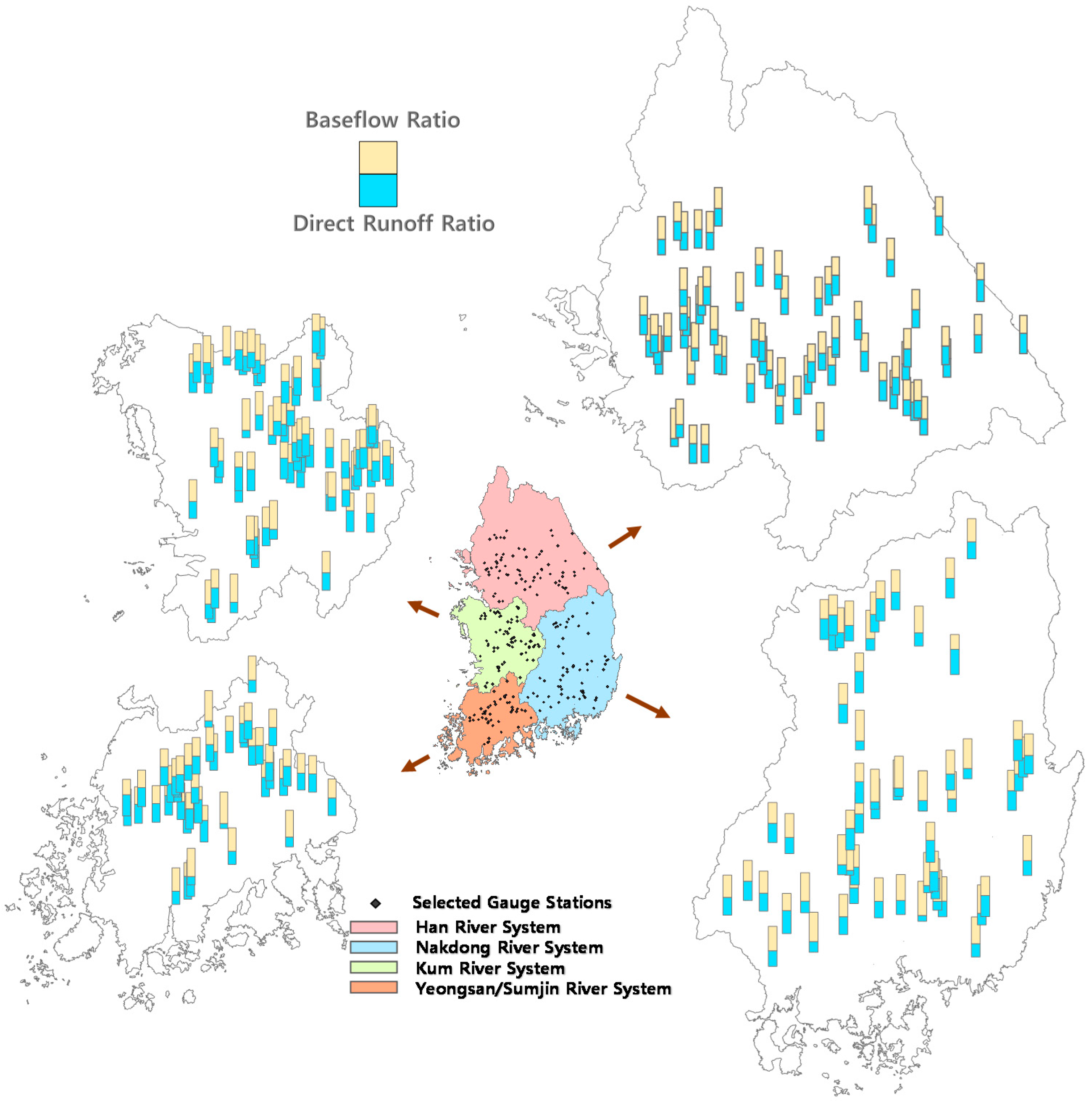
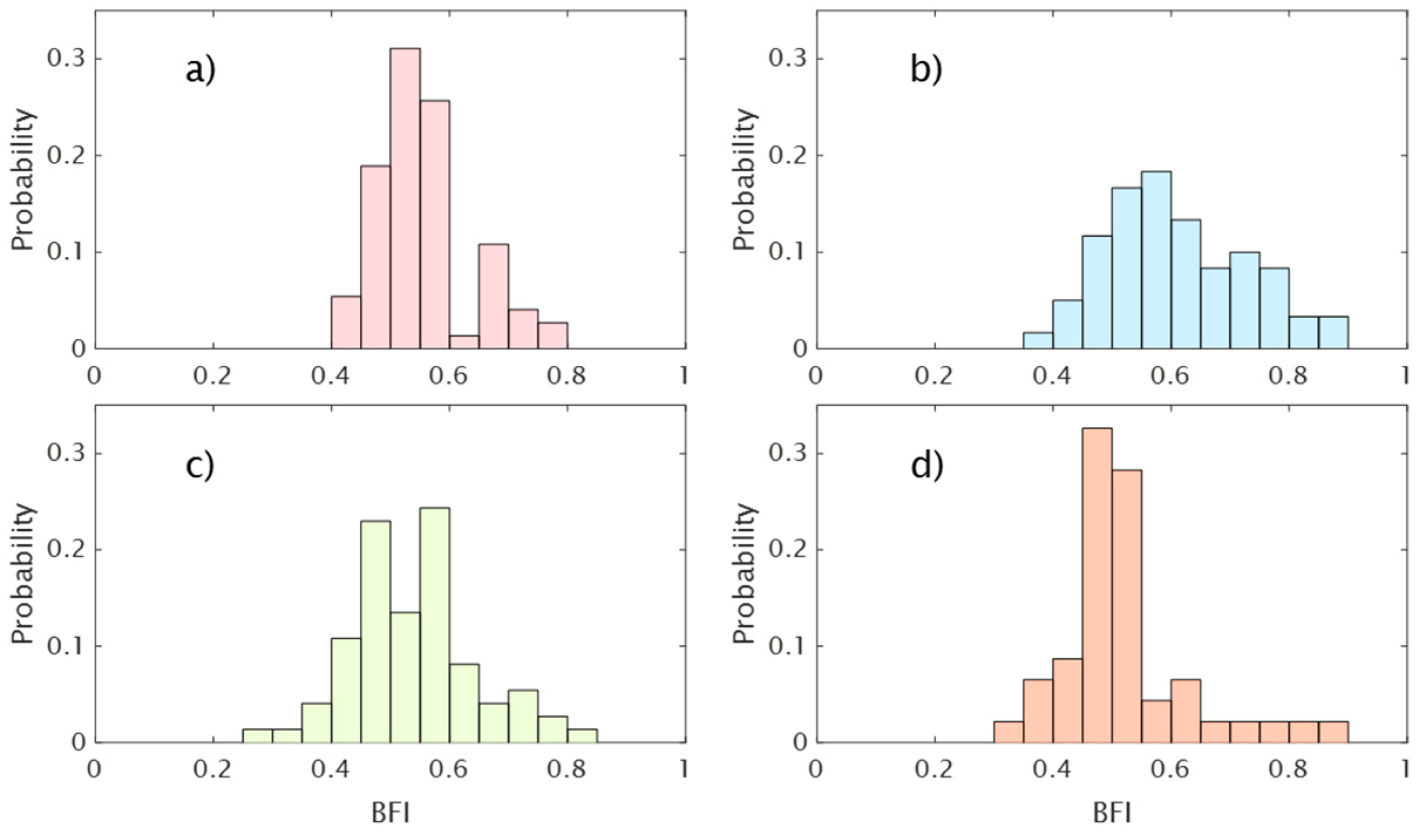

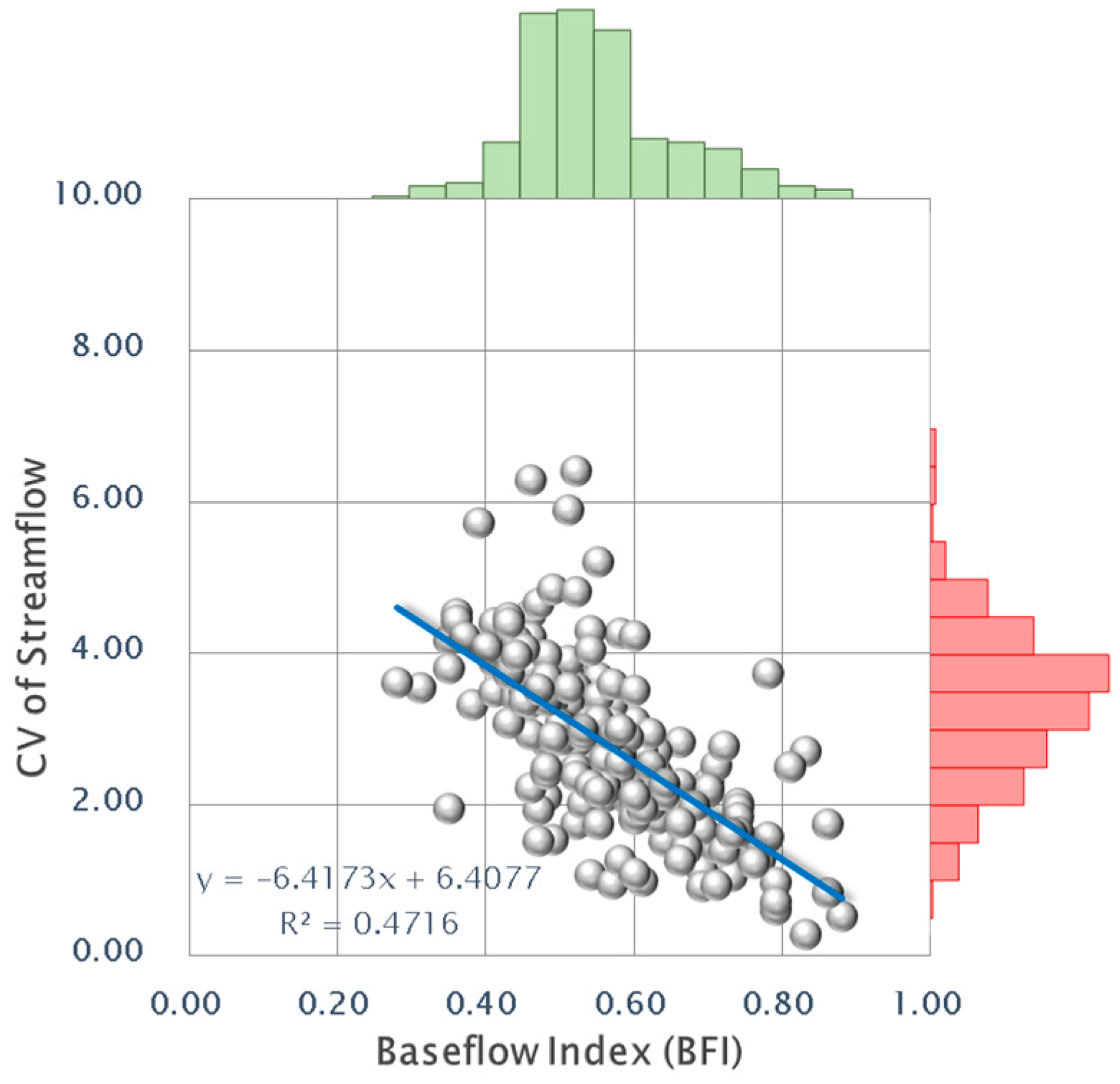


| Systems | Watersheds | Drainage Area (km2) | Perimeter (km) | Average Elevation (m) | Average Slope (%) | Highest Elevation (m) | |
|---|---|---|---|---|---|---|---|
| Code | Name | ||||||
| HR | 10 | Han River | 34,428 | 1335 | 407 | 39 | 1688 |
| 11 | Ansung Stream | 1659 | 240 | 70 | 15 | 571 | |
| 12 | E.S. Han River | 1971 | 1059 | 30 | 12 | 472 | |
| 13 | W.S. Han River | 3890 | 680 | 372 | 47 | 1705 | |
| NR | 20 | Nakdong River | 23,690 | 1097 | 291 | 37 | 1915 |
| 21 | Hyungsan River | 1140 | 226 | 176 | 31 | 846 | |
| 22 | Taehwa River | 661 | 162 | 187 | 31 | 1233 | |
| 23 | Heoya, Suyeong River | 865 | 342 | 128 | 27 | 902 | |
| 24 | E.S. Nadong River | 2968 | 795 | 238 | 44 | 1139 | |
| 25 | W.S. Nadong River | 2460 | 2102 | 121 | 34 | 873 | |
| GR | 30 | Gum River | 9914 | 738 | 224 | 32 | 1611 |
| 31 | Sapgyo Stream | 1668 | 269 | 85 | 20 | 698 | |
| 32 | W.S. Gum River | 2975 | 1007 | 54 | 17 | 904 | |
| 33 | Mangkyeong, Dongjin River | 3367 | 619 | 80 | 18 | 1112 | |
| YSR | 40 | Sumjin River | 4914 | 671 | 301 | 38 | 1650 |
| 41 | S.S. Sumjin River | 3385 | 2284 | 119 | 30 | 1223 | |
| 50 | Yeongsan River | 3470 | 435 | 111 | 24 | 1177 | |
| 51 | Tamjin River | 506 | 134 | 167 | 34 | 802 | |
| 52 | S.S. Yeongsan River | 1507 | 768 | 54 | 20 | 699 | |
| 53 | S.S. Yeongsan River | 2123 | 1823 | 49 | 19 | 740 | |
| Systems | Index | BFI | CV | ADDF | ADBF |
|---|---|---|---|---|---|
| HR | Min | 0.41 | 0.62 | 0.7 | 0.9 |
| Max | 0.79 | 6.41 | 546.0 | 526.8 | |
| Avg. | 0.55 | 2.80 | 40.0 | 61.1 | |
| NR | Min | 0.37 | 0.29 | 0.6 | 0.6 |
| Max | 0.89 | 5.89 | 378.9 | 736.6 | |
| Avg. | 0.61 | 2.64 | 40.9 | 78.9 | |
| GR | Min | 0.28 | 0.71 | 0.4 | 0.3 |
| Max | 0.81 | 6.29 | 162.1 | 214.9 | |
| Avg. | 0.54 | 2.94 | 10.6 | 17.6 | |
| YSR | Min | 0.35 | 1.28 | 0.5 | 0.5 |
| Max | 0.86 | 4.53 | 75.1 | 81.3 | |
| Avg. | 0.52 | 3.02 | 10.6 | 12.0 | |
| Total (Korea) | Min | 0.28 | 0.29 | 0.4 | 0.3 |
| Max | 0.89 | 6.41 | 546.0 | 736.6 | |
| Avg. | 0.56 | 2.84 | 26.4 | 43.7 |
© 2016 by the authors; licensee MDPI, Basel, Switzerland. This article is an open access article distributed under the terms and conditions of the Creative Commons Attribution (CC-BY) license (http://creativecommons.org/licenses/by/4.0/).
Share and Cite
Jung, Y.; Shin, Y.; Won, N.-I.; Lim, K.J. Web-Based BFlow System for the Assessment of Streamflow Characteristics at National Level. Water 2016, 8, 384. https://doi.org/10.3390/w8090384
Jung Y, Shin Y, Won N-I, Lim KJ. Web-Based BFlow System for the Assessment of Streamflow Characteristics at National Level. Water. 2016; 8(9):384. https://doi.org/10.3390/w8090384
Chicago/Turabian StyleJung, Younghun, Yongchul Shin, Nam-Il Won, and Kyoung Jae Lim. 2016. "Web-Based BFlow System for the Assessment of Streamflow Characteristics at National Level" Water 8, no. 9: 384. https://doi.org/10.3390/w8090384





